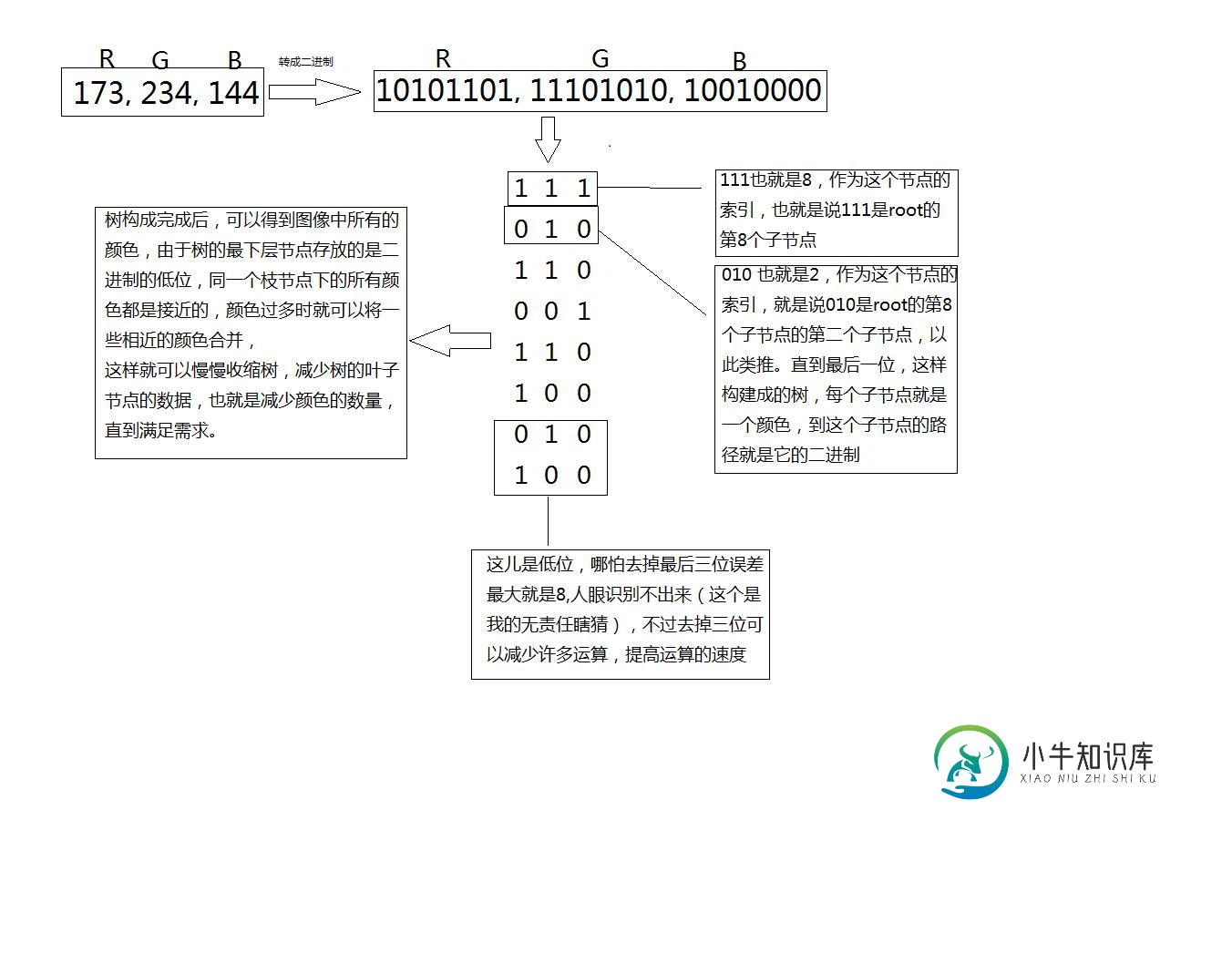java简单实现八叉树图像处理代码示例
一晃工作有段时间了,第一次写博客,有点不知道怎么写,大家将就着看吧,说的有什么不正确的也请大家指正。
最近工作中用到了一个图像压缩的功能。找了一些工具,没有太好的选择。最后选了一个叫jdeli的,奈何效率又成了问题。我迫于无奈就只能研究了下它的源码,却发现自己对它的一个减色量化算法起了兴趣,可是尴尬的自己完全不明白它写的什么,就起了一个自己实现一个量化颜色算法的念头。
自己找了一些资料,找到三个比较常用的颜色处理算法:
流行色算法:
具体的算法就是,先对一个图像的所有颜色出现的次数进行统计,选举出出现次数最多的256个颜色作为图片的调色板的颜色,然后再次遍历图片的所有像素,对每个像素找出调色板中的最接近的颜色(这里我用的是方差的方式),写回到图片中。这个算法的实现比较简单,但是失真比较严重,图像中一些出现频率较低,但对人眼的视觉效挺明显的信息将丢失。比如,图像中存在的高亮度斑点,由于出现的次数少,很可能不能被算法选中,将被丢失。
中位切分算法:
这个算法我没有研究,想要了解的同学,可以看下这篇文章,里面有三种算法的介绍。
八叉树
这个算法就是我最后选用的算法,它的主要思想就是把图像的RGB颜色值转成二进制分布到八叉树中,例如:(173,234,144)
转成二进制就是(10101101,11101010,10010000),将R,G,B的第一位取出来组成(111),作为root节点的子节点,其中111作为root子节点数组的索引,以此类推,一直到最后一位,然后在叶子节点上存放这个颜色的分量值以及其出现的次数。具体看图。

其中我比较疑惑的有一个处理就是叶子节点的合并策略,这儿我用的最笨的一个方法,就是找到层次最深的节点,然后合并,有点简单粗暴,有别的比较好的方法,也请大家给我留言。图片太大上传不了了,直接上代码了,代码没有重构,大家凑合看吧。
package com.gys.pngquant.octree;
import java.util.ArrayList;
import java.util.HashMap;
import java.util.List;
import java.util.Map;
/**
*
*
* @ClassName 类名:Node
* @Description 功能说明:
* <p>
* 八叉树实现
* </p>
*
* 2015-12-16 guoys 创建该类功能。
*
**********************************************************
* </p>
*/
public class Node{
private int depth = 0;
// 为0时为root节点
private Node parent;
private Node[] children = new Node[8];
private Boolean isLeaf = false;
private int rNum = 0;
private int gNum = 0;
private int bNum = 0;
private int piexls = 0;
private Map<Integer, List<Node>> levelMapping;
// 存放层次和node的关系
public int getRGBValue(){
int r = this.rNum / this.piexls;
int g = this.gNum / this.piexls;
int b = this.bNum / this.piexls;
return (r << 16 | g << 8 | b);
}
public Map<Integer, List<Node>> getLevelMapping() {
return levelMapping;
}
public void afterSetParam(){
if(this.getParent() == null && this.depth == 0){
levelMapping = new HashMap<Integer, List<Node>>();
for (int i = 1; i <= 8; i++) {
levelMapping.put(i, new ArrayList<Node>());
}
}
}
public int getrNum() {
return rNum;
}
public void setrNum(int rNum) {
if(!isLeaf){
throw new UnsupportedOperationException();
}
this.rNum = rNum;
}
public int getgNum() {
return gNum;
}
public void setgNum(int gNum) {
if(!isLeaf){
throw new UnsupportedOperationException();
}
this.gNum = gNum;
}
public int getbNum() {
return bNum;
}
public void setbNum(int bNum) {
if(!isLeaf){
throw new UnsupportedOperationException();
}
this.bNum = bNum;
}
public int getPiexls() {
return piexls;
}
public void setPiexls(int piexls) {
if(!isLeaf){
throw new UnsupportedOperationException();
}
this.piexls = piexls;
}
public int getDepth() {
return depth;
}
// 返回节点原有的子节点数量
public int mergerLeafNode(){
if(this.isLeaf){
return 1;
}
this.setLeaf(true);
int rNum = 0;
int gNum = 0;
int bNum = 0;
int pixel = 0;
int i = 0;
for (Node child : this.children) {
if(child == null){
continue;
}
rNum += child.getrNum();
gNum += child.getgNum();
bNum += child.getbNum();
pixel += child.getPiexls();
i += 1;
}
this.setrNum(rNum);
this.setgNum(gNum);
this.setbNum(bNum);
this.setPiexls(pixel);
this.children = null;
return i;
}
// 获取最深层次的node
public Node getDepestNode(){
for (int i = 7; i > 0; i--) {
List<Node> levelList = this.levelMapping.get(i);
if(!levelList.isEmpty()){
return levelList.remove(levelList.size() - 1);
}
}
return null;
}
// 获取叶子节点的数量
public int getLeafNum(){
if(isLeaf){
return 1;
}
int i = 0;
for (Node child : this.children) {
if(child != null){
i += child.getLeafNum();
}
}
return i;
}
public void setDepth(int depth) {
this.depth = depth;
}
public Node getParent() {
return parent;
}
public void setParent(Node parent) {
this.parent = parent;
}
public Node[] getChildren() {
return children;
}
public Node getChild(int index){
return children[index];
}
public void setChild(int index, Node node){
children[index] = node;
}
public Boolean isLeaf() {
return isLeaf;
}
public void setPixel(int r, int g, int b){
this.rNum += r;
this.gNum += g;
this.bNum += b;
this.piexls += 1;
}
public void setLeaf(Boolean isLeaf) {
this.isLeaf = isLeaf;
}
public void add8Bite2Root(int _taget, int _speed){
if(depth != 0 || this.parent != null){
throw new UnsupportedOperationException();
}
int speed = 7 + 1 - _speed;
int r = _taget >> 16 & 0xFF;
int g = _taget >> 8 & 0xFF;
int b = _taget & 0xFF;
Node proNode = this;
for (int i=7;i>=speed;i--){
int item = ((r >> i & 1) << 2) + ((g >> i & 1) << 1) + (b >> i & 1);
Node child = proNode.getChild(item);
if(child == null){
child = new Node();
child.setDepth(8-i);
child.setParent(proNode);
child.afterSetParam();
this.levelMapping.get(child.getDepth()).add(child);
proNode.setChild(item, child);
}
if(i == speed){
child.setLeaf(true);
}
if(child.isLeaf()){
child.setPixel(r, g, b);
break;
}
proNode = child;
}
}
public static Node build(int[][] matrix, int speed){
Node root = new Node();
root.afterSetParam();
for (int[] row : matrix) {
for (int cell : row) {
root.add8Bite2Root(cell, speed);
}
}
return root;
}
public static byte[] mergeColors(Node root, int maxColors){
byte[] byteArray = new byte[maxColors * 3];
List<byte> result = new ArrayList<byte>();
int leafNum = root.getLeafNum();
try{
while(leafNum > maxColors){
int mergerLeafNode = root.getDepestNode().mergerLeafNode();
leafNum -= (mergerLeafNode - 1);
}
}
catch(Exception e){
e.printStackTrace();
}
fillArray(root, result, 0);
int i = 0;
for (byte byte1 : result) {
byteArray[i++] = byte1;
}
return byteArray;
}
private static void fillArray(Node node, List<byte> result, int offset){
if(node == null){
return;
}
if(node.isLeaf()){
result.add((byte) (node.getrNum() / node.getPiexls()));
result.add((byte) (node.getgNum() / node.getPiexls()));
result.add((byte) (node.getbNum() / node.getPiexls()));
} else{
for (Node child : node.getChildren()) {
fillArray(child, result, offset);
}
}
}
}
可怜我大学唯二挂的数据结构。代码实现的只是八叉树,对一个1920*1080图片量化,耗时大概是450ms,如果层次-2的话大概是100ms左右。
好吧,这篇就这样吧,本来写之前,感觉自己想说的挺多的,结果写的时候就不知道怎么说了,大家见谅。
总结
以上就是本文关于java简单实现八叉树图像处理代码示例的全部内容,希望对大家有所帮助。感兴趣的朋友可以继续参阅本站其他相关专题,如有不足之处,欢迎留言指出。感谢朋友们对本站的支持!
-
本文向大家介绍JS二叉树的简单实现方法示例,包括了JS二叉树的简单实现方法示例的使用技巧和注意事项,需要的朋友参考一下 本文实例讲述了JS二叉树的简单实现方法。分享给大家供大家参考,具体如下: 今天学习了一下 二叉树的实现,在此记录一下 简单的二叉树实现,并且实现升序和降序排序输出 更多关于JavaScript相关内容感兴趣的读者可查看本站专题:《JavaScript数据结构与算法技巧总结》、《J
-
本文向大家介绍java 实现简单圣诞树的示例代码(圣诞节快乐),包括了java 实现简单圣诞树的示例代码(圣诞节快乐)的使用技巧和注意事项,需要的朋友参考一下 代码如下: 以上就是本文的全部内容,希望对大家的学习有所帮助,也希望大家多多支持呐喊教程。
-
本文向大家介绍javascript实现二叉树的代码,包括了javascript实现二叉树的代码的使用技巧和注意事项,需要的朋友参考一下 前言: 二叉树的特点(例图只是二叉树的一种情况,不要尝试用例图推理以下结论) 除了最下面一层,每个节点都是父节点,每个节点都有且最多有两个子节点; 除了嘴上面一层,每个节点是子节点,每个节点都会有一个父节点; 最上面一层的节点(即例图中的节点50)为根节点; 最下
-
本文向大家介绍C++ HLSL实现简单的图像处理功能,包括了C++ HLSL实现简单的图像处理功能的使用技巧和注意事项,需要的朋友参考一下 由于对于dxva2解码得到的数据不宜copy回内存给CPU处理,所以最好的办法是在GPU上直接进行处理。D3D的像素着色器能够对像素直接进行操作,实现点运算极其简单方便,简单的卷积运算效果也非常好。但D3D9的限制也很多,对于过于复杂的图像处理则显得有些不能胜
-
本文向大家介绍Java 队列实现原理及简单实现代码,包括了Java 队列实现原理及简单实现代码的使用技巧和注意事项,需要的朋友参考一下 Java 队列实现原理 “队列”这个单词是英国人说的“排”。在英国“排队”的意思就是站到一排当中去。计算机科学中,队列是一种数据结构,有点类似栈,只是在队列中第一个插入的数据项也会最先被移除,而在栈中,最后插入的数据项最先移除。队列的作用就像电影院前的人们站成
-
本文向大家介绍python实现二叉查找树实例代码,包括了python实现二叉查找树实例代码的使用技巧和注意事项,需要的朋友参考一下 本文研究的主要是python实现二叉查找树的相关内容,具体介绍及实现如下。 1. 二叉查找树的定义: 左子树不为空的时候,左子树的结点值小于根节点,右子树不为空时,右子树的结点值大于根节点,左右子树分别为二叉查找树 2. 二叉查找树的最左边的结点即为最小值,要查找最小

